Balanced Logistics
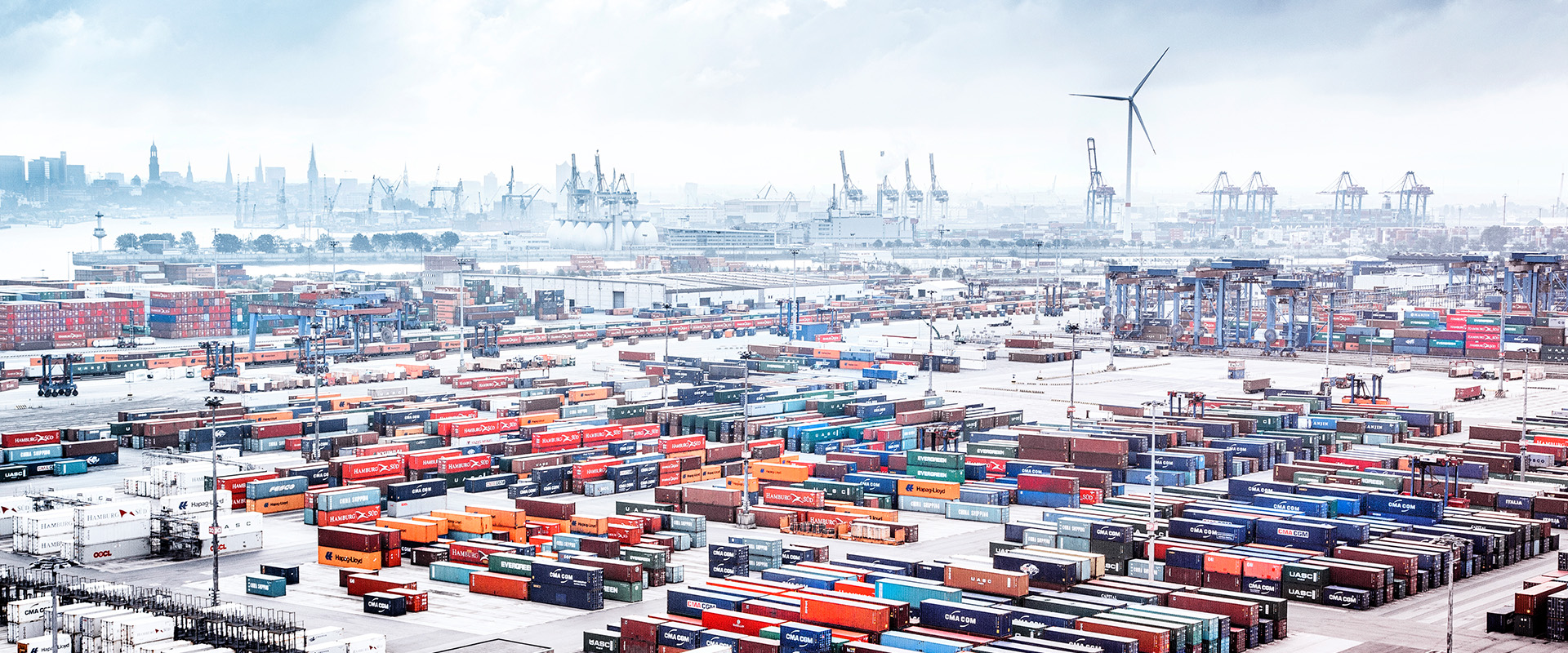
Balanced Logistics – for sustainable solutions
As a company that takes its responsibilities seriously, HHLA’s sustainability programme stands for Balanced Logistics – a firm commitment to be both economically successful as well as socially and ecologically responsible.
With the implementation of its Balanced Logistics sustainability strategy, HHLA is demonstrating its commitment to reconciling environmental, social and economic responsibility. Each is a prerequisite for the others: economic success provides the company with the means and opportunity to invest in its employees and climate-friendly technologies, while at the same time maintaining its responsibility to society and the environment.
HHLA regards innovation and process efficiency as crucial elements for developing sustainable solutions, acting in an environmentally responsible manner and operating successfully in line with its self-image as the “Gateway to the Future”. In order to systematically implement its goals, HHLA pools its initiatives in nine different fields of activity with their own guidelines and targets.
Open dialogue with our stakeholders is essential for reconciling different interests and developing a mutual understanding. Sustainable growth in logistics requires inspiration and constructive contributions from many different sides.
HHLA has set itself the goal of becoming a
climate-neutral Group by 2040.
For example, the field of climate-friendly logistics chains goes beyond optimising our own processes and technology. In particular, networking with other logistics players offers further potential for joint solutions. HHLA pursues this path, for example, by integrating various stakeholders along the supply chains, by exchanging data, and by undertaking joint research projects with manufacturers, the scientific community and other companies.
Our sustainability projects 2019
Through technological developments, process optimisation and knowledge transfer, HHLA has been able to reconcile its entrepreneurial success with its responsibility towards the climate and society for many years now. The following reports on projects and initiatives with which we work to achieve our sustainability goals and thus also contribute to the sustainability goals of the United Nations.
Choose one of the three dimensions of sustainability to filter project reports by topic and to see which sustainability goals of the United Nations they contribute to.
Environmentally friendly logistics chains
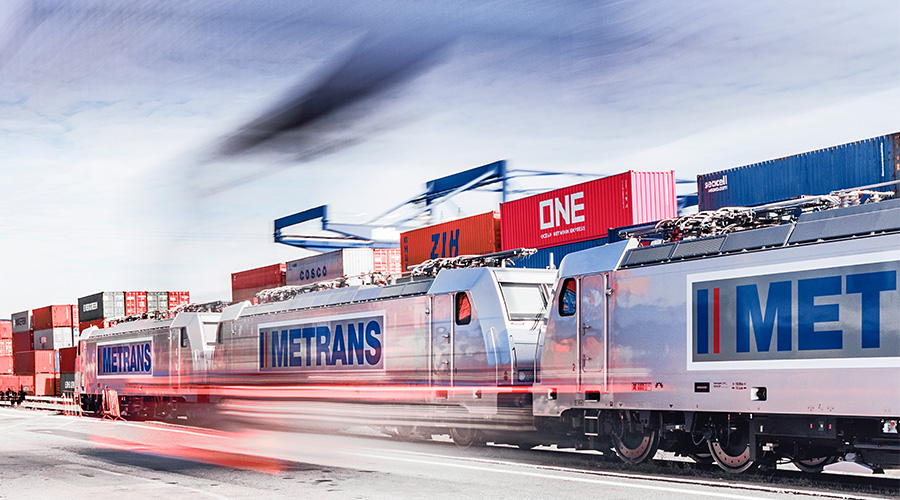
HHLA shifts containers to the rails with the aid of subsidiary METRANS
HHLA optimises all stages of intelligent container logistics – and does not stop at the quayside. HHLA subsidiary METRANS, for example, provides frequent rail links between the seaports of the North Sea and the Adriatic. The METRANS Group is the market leader for seaport-hinterland container traffic with Central, Eastern and South-Eastern Europe. 16 own inland terminals, special locomotives and environmentally friendly container transport wagons enable flexible and climate-friendly transportation.
With the aid of METRANS, HHLA ensures that more and more container transports are transferred from road to rail. The HHLA subsidiary thus makes a significant contribution towards creating environmentally and climate-friendly logistics chains. As a result, the proportion of containers transported by rail in the Port of Hamburg’s hinterland has increased by over 25 % in the past ten years.
Transport-related CO2 emissions account for around one-fifth of global greenhouse gas emissions. Rail transport is seen as the most environmentally sustainable mode of hinterland transport. By connecting the port terminals with the European hinterland, HHLA offers a climate-friendly logistics network.
METRANS also uses energy-efficient electric trains and CO2 optimised lightweight flat wagons, which can transport more containers with the same train length. This reduces energy consumption and minimises noise emissions.
30 % lighter than the average rolling material in Europe is the total weight of a container carrier designed by HHLA.
With HHLA Pure, the company has also developed a product that not only offers its customers climate-neutral container handling in the Port of Hamburg but also climate-neutral transport from Hamburg to the European hinterland.
HHLA successfully recruited logistics company Jakob Weets and transport specialist cargo-partner as pilot customers. METRANS now manages container transports for both companies from the Port of Hamburg to Central and Eastern Europe. If, for instance, the handling and rail transport of a 20-foot container from Container Terminal Altenwerder to Prague, roughly 700 kilometres away, generates a CO2 footprint of approximately 80 kg per standard container (TEU) this certified value can be offset with HHLA Pure.
HHLA demonstrates that climate-friendly transport chains are already possible today.
Greenhouse gas emissions that cannot yet be technologically prevented are offset by certified development projects that meet the highest international standards. The climate-neutral status of the container transport is certified by TÜV Nord and confirmed for customers that use HHLA Pure.
Area optimisation
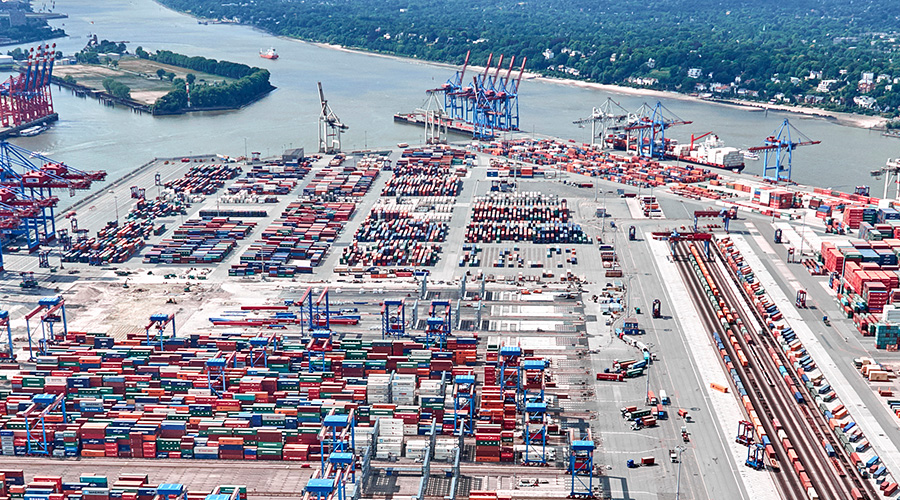
Intelligent terminal layout for more efficient use of space
According to the German government’s Climate Action Plan and the European Union’s Resources Strategy, the transition to circular land use is to be completed by 2050 at the latest. The aim is to stop the increasing use of land, as its allocation for transport, work and residential purposes has a major impact on the environment.
The increase in capacity is an essential measure to cope with rising handling volumes and peak load situations.
Land is a valuable, but limited, resource. This is even more the case for harbour areas that can handle ocean-going vessels. Efficient land usage and capacity planning at the terminals with minimal use of space are core issues for HHLA. The efficient planning of infrastructure and suprastructure plays a major role in these efforts, as evidenced by the expansion programme at the HHLA Container Terminal Burchardkai (CTB), the largest terminal in the Port of Hamburg.
By a factor of 2 the storage capacity is increased thanks to an automated storage crane system
Until 2009, the horizontal transport of containers at CTB was handled exclusively by straddle carriers. In this set-up, containers being stacked in the onshore yard by straddle carriers required lanes on either side of the container, which take up space. The height of the straddle carrier also limits the maximum height of a stack of containers. In 2009, HHLA started work on the expansion of an automated storage crane system, which comprises three portal cranes per block. On the one hand, this means that access lanes are no longer necessary and the space required for storing the containers is significantly condensed. The containers can also be stacked to greater heights. The result is much more efficient use of the available space.
These changes mean that the storage capacity for the same space has doubled. The distance travelled between the container gantry cranes and the yard is also shorter. Horizontal and vertical transport in the block storage area is also operated by a system that runs on green electricity.
Higher and denser A considerable compression and higher stacking of the containers leads to a more efficient use of space
In addition to other efficiency-boosting measures, the increased storage capacity is a prerequisite for the management of increasing throughput and peak workloads. At the same time, the amount of space available is being used even more efficiently.
Climate protection and energy efficiency
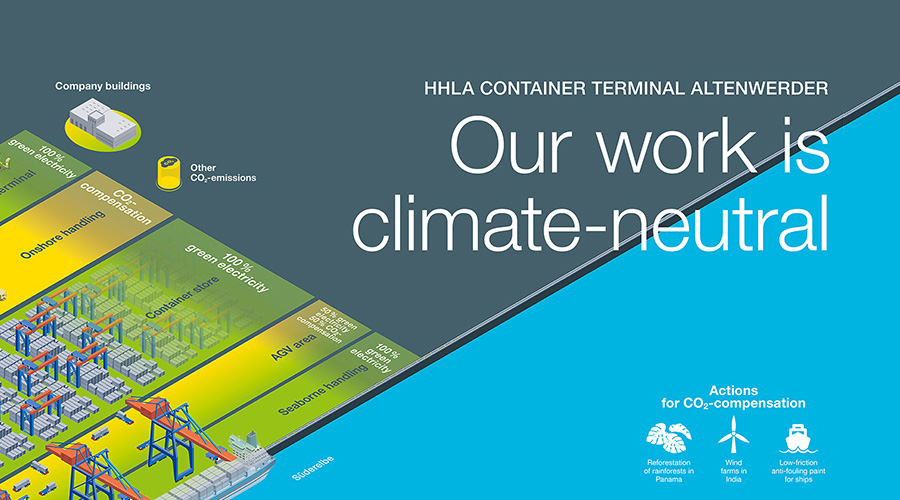
The world’s first climate-neutral container terminal
One of the key focus areas of HHLA’s sustainability strategy is the creation of climate-friendly logistics chains from the Port of Hamburg to the European hinterland via rail. The Container Terminal Altenwerder (CTA) is one of the world’s most technologically advanced and efficient terminals. It has undergone continuous development since it first went into operation in 2002. Operations at CTA are now primarily powered by green electricity. Terminal processes still emitting CO2 today are being gradually electrified, or their transition to electrical power is being field-tested. 14 electric container gantry cranes powered 100 % by green energy are used for the seaborne handling process.
The HHLA Container Terminal Altenwerder is the world’s first container handling facility to be certified climate-neutral.
One hundred automated guided vehicles (AGVs) transport the containers to and from the block storage area. Around 50 % of the AGVs are already operated solely using green electricity. By 2022, all AGVs will have been converted to fast-charging lithium-ion batteries.
Within the all-electric block storage areas, 52 gantry cranes are used to move the containers around. All cranes are powered 100 % by green electricity. The 90-degree angle between the cranes and the quay wall keeps the distances between the container gantry cranes and the storage blocks short. Operated on rails, the gantry cranes can pick up and deposit containers on both sides of a block, where up to five containers can be stacked on top of one another and ten next to each other. In comparison to yards where straddle carriers move the containers – requiring lanes to be kept clear for them – the capacity of the same space is doubled. CTA’s intelligent container logistics system therefore not only facilitates low-emission handling but also ensures more efficient use of land for container storage.
In terms of onshore handling, we are currently conducting prototype tests with battery-powered locomotives between block storage and rail terminal. The rail terminal comprises four electric rail gantry cranes and a fleet of electric cars that are used as monitoring vehicles at the terminal and powered 100 percent by green electricity.
Any remaining CO2 emissions are offset via emission reduction certificates. In its offsetting activities, HHLA supports climate-friendly projects that are certified according to the highest Gold Standard of Voluntary Emission Reduction (VER), including wind farms in India, low-friction anti-fouling paint for ship hulls and the reforestation of rainforests in Panama.
Environment and resource protection
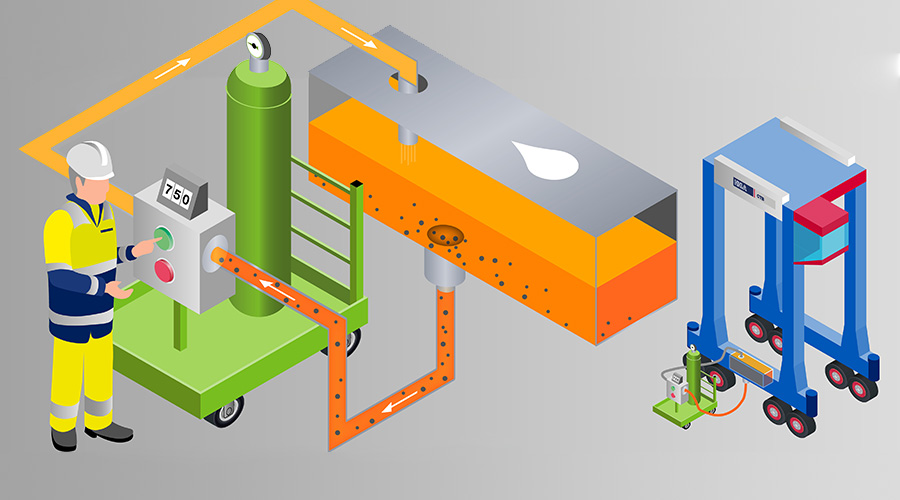
Smart diesel-cleaning technology conserves resources
They dominate the landscape of the HHLA Container Terminal Burchardkai (CTB): long-legged container transporters, which move the boxes between ship, yard and rail terminal. In the Port of Hamburg, these manned systems are known as straddle carriers.
Straddle carriers are powered by diesel and electricity. Because the tank is never completely emptied, impurities may form in the fuel and settle on the floor of the tank over time. These impurities increase the wear on the vehicle because they build up in injection nozzles and fuel pumps in particular and can block them. To prevent this, the impure fuel must be regularly emptied out of the tank and disposed of properly.
In order to reduce diesel consumption and at the same time minimise the amount of impure diesel to be disposed of, HHLA operates a fine filtration unit at Burchardkai. The mobile fine filtration unit is connected to the straddle carrier’s storage tank in order to clean the impure portion. During the filtration process, water is reliably separated from solids, ensuring the purity of the fuel. The cleaned diesel is then fed back into the tank.
Since the filtration unit has been in operation, between 50,000 and 100,000 litres of impure diesel have been cleaned directly in the straddle carriers every year. Because this amount is almost completely fed back into the straddle carrier tanks as purified fuel, only around one cubic metre of impure fuel per year now requires special disposal – previously, this amount was up to 100,000 litres per year. The measure also pays off from an economic point of view: diesel procurement and disposal costs have decreased demonstrably.
Health and occupational safety

“The framework of port work has undergone a major change.”
Interview with Norbert Smietanka, head of HHLA’s occupational safety management team
Mr Smietanka, you have headed HHLA’s occupational safety management team for 12 years. How have the requirements of an effective occupational health and safety management system changed during this time?
The framework of port work has undergone a major change. We’ve experienced an enormous increase in throughput, which has concentrated the work. HHLA has had to respond to this. As an employer, HHLA has a responsibility towards its employees. The company must ensure that health and safety adapt to the changing work environment. Entire processes are constantly being reorganised. The increase in throughput has led to more vehicles moving around the terminals at certain times of peak workload, for example, which increases the risk of accidents. In order to be able to process this volume of traffic efficiently, HHLA has introduced its slot-booking process. There is now a specific processing window assigned to each heavy goods vehicle. This reduces truck bottlenecks and peak traffic periods and minimises the risk of accidents.
“We train our employees and raise awareness to firmly establish safety-conscious behaviour in their minds.”
What are the main risks with port work, and what does HHLA do to minimise them?
We see a general risk in cargo handling. We therefore investigate to find out at which sites the accidents or near misses occurred. Risk analyses and risk assessments help us develop specific measures to reduce the overall risk. This starts with facility specifications. One example: in order to minimise musculoskeletal disorders resulting from the use of handling equipment – also by older workers – driver seats and cabins are constantly being redesigned and specifications are taken into account when we procure new equipment.
Are there terminals where safeguarding health and safety is particularly challenging due to the conditions there?
No. There are challenges everywhere, at every terminal. Our facilities differ primarily with regard to their degree of automation. In general, one can say that automation reduces many risks but cannot completely eliminate them.
What consequences does increased automation in container handling have on health and safety at the terminals?
Automation creates terminal processes where people are less directly involved with the actual handling of cargo and instead direct activities from a control centre, for example. This naturally reduces risks. Accidents where people are injured will become rarer. But automated facilities also have to be maintained and repaired, which results in new risks.
To what extent are HHLA’s efforts having an impact on accident statistics?
Accident numbers have continually declined over the years. However, there will come a point when they can hardly be reduced any more. This also has to do with human behaviour. These days, people sometimes trip on the stairs because they are looking at their smartphone. That didn’t happen twelve years ago. It simply wasn’t typical for someone to have an accident because they were leafing through a folder while climbing the stairs.
Working world

HHLA trains the Pilots of the Future
The logistics industry is rapidly changing. Digitalisation is fundamentally altering the industry: automated container throughput, self-driving cars, drone technology and 3D printing are just a few striking examples. One of HHLA’s answers to this rapid rate of change and the increased complexity of these forward-looking topics is its new Pilots of the Future training programme. This course teaches employees the skills needed to drive forward and implement the company’s digital transformation. The programme is a major pillar in HHLA’s strategy to promote the knowledge and skills of its employees. In 2019, for example, HHLA invested €4.6 million in employee training in Hamburg alone.
The Pilots of the Future programme focuses on learning agile project management methods and developing an empathetic leadership style, which is essential for successful digital transformation. In 2019, 18 senior executives, young managers and project managers were the first to start their training as Pilots of the Future.
The first Pilots of the Future will attend four one-week courses in the period up to September 2020. The training programme focuses on container processes in the digital revolution; agile management methods such as scrum and design thinking; and current innovation models, such as for decision-making processes and strategy development. Another area of focus is collaboration in complex organisations. The participants work on the content in small teams using practical examples.
With the skills they learn, the Pilots of the Future will play a major role in shaping HHLA’s digital transformation and thus promoting the sustainable growth of the company. With the aid of modern project management and leadership methods, they will be able to implement the projects needed for the digital transformation more quickly and efficiently while providing their colleagues with the best possible support.
Social responsibility
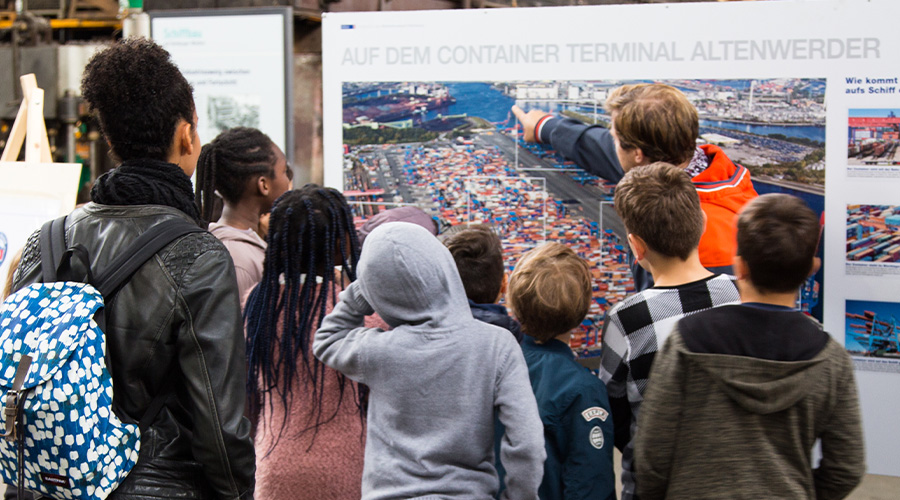
“Hafen-Scouts” explore maritime logistics
Hamburg is a port. And its harbour has long shaped the development of the metropolis on the river Elbe, giving it its nickname “The gateway to the world”. The port is the economic heart of a metropolitan region, the biggest commercial hub of the export nation Germany, and the region’s most important employer. It is part of the city’s DNA.
As a high-performance hub for freight from around the world, Hamburg’s container terminals handle millions of steel boxes with the aid of cutting-edge information technology. The goods delivered in containers – bikes, soft toys, bananas and jeans – also end up in the homes of Hamburg’s primary school pupils. As “Hafen-Scouts” (or port scouts), the pupils learn about the journeys these goods have made, how the port works and what careers Hamburg’s logistics hub offers.
Exploring trip between history and the present
The “Hafen-Scouts” project was initiated by HHLA, the Hafenmuseum Hamburg (port museum) and the State Institute for Teacher Training and School Development in 2015. It offers children in their final year of primary education the chance to embark on a one-day educational trip around the Port of Hamburg as the highlight of an instructive module on maritime logistics. The content of the educational trip forms part of the syllabus for the participating classes and is prepared for and followed up intensively in class. All teachers who sign up their classes for the trip take part in a port induction course beforehand.
The pupils’ journey of exploration begins in the port museum, where they are taken on a tour of the Port of Hamburg as it was in the past and is today: How has work at the port changed? Why do container ships keep getting bigger? How do bananas make it to my table? The port museum allows the pupils to discover answers to questions like these in an entertaining way. Touching and experimenting is most certainly desired. The “Hafen-Scouts” discover how the job of a docker has changed over the decades and what ship planners and container gantry crane operators actually do. The highlight of this journey of discovery through the museum is a special container modified by HHLA. It showcases the diverse range and volume of goods transported around the world in these standardised boxes. Inside the box, pupils learn that many products of their daily lives arrive in Germany by container every day. The young adventurers then have to guess how many objects fit in a container and learn how far the different goods travel by ship to Hamburg.
The journey of discovery ends with the pupils visiting the world’s first certified climate-neutral container terminal: the highly automated HHLA Container Terminal Altenwerder (CTA). After already discovering in the museum which stations a container passes through at the terminal, pupils can then marvel at them on site. In addition to the container ships at the quay wall, the children are especially fascinated by the automated transport vehicles (ATVs) that move the containers around the terminal as if by magic.
More than 6,000 schoolchildren have already visited the Port of Hamburg as part of this educational project.
Experiencing modern container handling up close makes a big impression on the young port experts, and experience shows that this day of adventure stays with them for many years. In 2019, a total of 66 classes embarked on this journey of discovery in the Port of Hamburg, with nearly 1,500 “Hafen-Scouts” taking part in 33 excursions. Since the project was launched in 2015, 6,000 schoolchildren have already visited the Port of Hamburg as part of this educational project.
Business partners

“At HHLA, sustainability and compliance go hand in hand”
Interview with Dr. John Maurer, Compliance Officer at HHLA
Dr. Maurer, as our Compliance Officer, you are responsible for the Group-wide compliance management system of Hamburger Hafen und Logistik AG. Which criteria does HHLA use to decide with whom it works?
At HHLA, our business relationships are not left to chance. We are currently launching a business partner screening system for the Group which enables us to evaluate existing and potential business partners from a risk-based perspective. This screening process allows us to get a better idea of who we are working with. The system uses criteria such as integrity in business operations, political affiliations and information from law enforcement authorities.
It also draws on public information from databases. This helps us find out whether potential business partners are included on sanction lists. All information from the screening process is then fed into a risk-based evaluation.
How exactly does this evaluation work?
We primarily look to see whether the information indicates a concrete risk for the business relationship. This evaluation is condensed into a kind of extended traffic light system: if a business relationship presents no risk, or a very low risk, it is rated “green”, while higher risks are given a “red” rating. Unacceptable risks, such as those posed by companies on EU sanction lists, get a “black” rating. This rules out a business relationship as in such cases the risk would be too high for HHLA.
What does HHLA do, apart from business partner screening, to minimise the risks associated with business partners?
HHLA expects its suppliers to comply with standards such as those we have set ourselves in our Code of Conduct.
During risk assessment, it is important to bear in mind that our supplier structure is of course quite different from that of a manufacturing company. If a textile company buys cotton from Uzbekistan and manufactures textiles in Bangladesh or Pakistan, for example, their view of supplier risk is quite different to ours. HHLA shapes logistics processes.
Nevertheless, we believe that our responsibility extends far beyond the quayside in the Port of Hamburg. We therefore require that our business partners align themselves with our standards and are currently introducing a Supplier Code of Conduct throughout the Group.
How do you evaluate new business fields, such as 3D printing, with regard to compliance?
The risk structure can change with new business fields. With 3D printing for example, we are involved in manufacturing. This means HHLA now has new requirements and must deal with such aspects as product liability and marketing risks. The profile is also changing in terms of our suppliers: the sourcing of raw materials, for example, alters the risk analysis.
“Compliance management is a ‘living’ system that is constantly evolving and which also comprises relationships with our business partners.”
What is HHLA aiming to achieve with its compliance management system?
Compliance is closely tied to a company’s corporate culture. Integrity, fairness, responsibility and sustainability are key values that shape our day-to-day working lives at HHLA.
HHLA is the “gateway to the future” and our compliance management system helps us shape business relationships on the basis of our values, together with partners who are a good fit for us and our philosophy.
Added value and innovation
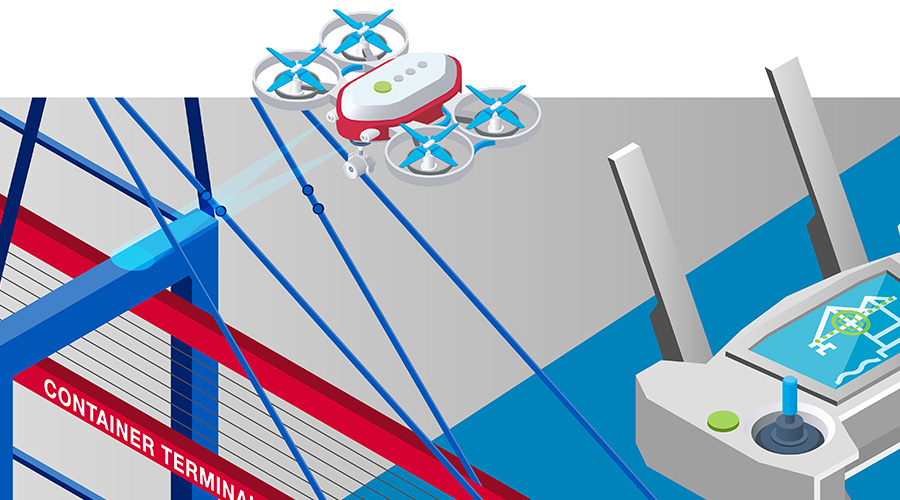
Drones inspect container gantry cranes at CTT
Container gantry cranes define the skyline of the Port of Hamburg. Positioned on the quay wall, they form the interface with the terminals and are the first stop for the gigantic container ships after weeks at sea.
The container gantry cranes at Container Terminal Tollerort (CTT) even handle ultra large container vessels with a capacity of up to 20,000 standard containers (TEU) – and one 20-foot container can weigh as much as 30 tonnes. The gantry cranes are subjected to constant stress as they load and unload these maritime giants.
They are therefore regularly inspected to ensure they work seamlessly and to prevent potential accidents. Instead of sending an industrial climber up the 93-metre-high crane, however, HHLA now uses drones to inspect the container gantry cranes at CTT. The remote-controlled drone checks whether the giant steel structures show any signs of fatigue along their weld seams or any other areas subject to heavy use. The gantry crane’s condition is no longer checked from on high but can be done conveniently and safely on a screen. Depending on which type of container gantry crane is being inspected and the manufacturer’s inspection specifications, the container gantry cranes are checked by drones up to four times a year. The data from the inspection flights is saved, allowing for subsequent reconstruction of how a container gantry crane ages over time.
Drone inspections offer HHLA several advantages: for one thing, they present a much lower risk than inspection by a climber. And for another thing, drone inspections require much less time, so the container gantry crane is back in action faster and can get back to work handling containers.